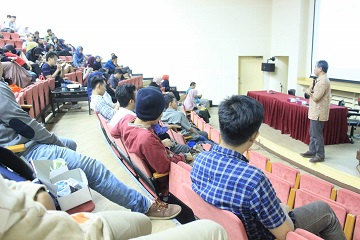Ten Steps to Become a Great Exporter of Agricultural Products

Tenant business incubators participated in the Agricultural Product Export Lecture that was held by the Directorate of Technology Science Area and Business Incubator (DKSTIB) of the Bogor Agricultural Institute (IPB), Wednesday (27/2) at Dramaga’s IPB Campus. The activity that was followed by the students of the IPB Postgraduate School was exciting. In his speech the Director of the Technology Science Area and Business Incubator of IPB, Dr. Rokhani stated that for the success of agricultural product exports, it is necessary to pay attention to four main issues, namely food safety, trace back, consumer education and product branding.
“Food safety is mainly related to pesticide residues and positive list regulation. Trace back recall to trace treatments before harvesting. Consumer education is related to functional food and nutritional value. “Product branding concerns availability, continuity and quality consistency,” explained Dr. Rokhani.
Ir. Nursyamsu Mahyuddin, MM, business practitioners engaged in agricultural product exports reminded of free market competition especially for the ASEAN Economic Community which in practice has five types of free flows namely free flow of goods, free flow of services, free flow of skilled labor, free flow investment and free flow of capital.
“The definition of export is the activity of removing goods from the customs area. Customs area is the territory of the Republic of Indonesia which covers the territorial waters, land and air space above it and certain places in the Exclusive Economic Zone and continental shelf in which customs regulations apply. The document requirements that must be prepared by the exporter are Taxpayer Identification Number / NPWP (tax service office), Trading Business License / SIUP (integrated licensing service of regency or city), Company Registration Certificate / TDP (District / City Integrated Licensing Service) and “The Customs / NIK Parent Number (Directorate General of Customs and Excise),” said Nursyamsu.
According to Nursyamsu, there are ten steps to becoming an exporter, which are: establishing reliable products and export destination countries, building business networks, preparing combat equipment (business cards, brochures, catalogs, product specifications, prices), owning websites, promoting through the internet (business portal, facebook), Search Engine Optimation (SEO) web, prepares letter models on computers (introduction letter, quotation, sales contract), prepares product samples, follows trade shows at home and abroad and at a computer at least two hours per day ( to study export-import data, market analysis, register on business portals, identify export destination countries, etc.).
Furthermore Nursyamsu said that as for the types of potential products for exports including skin and leather products, medical equipment, medicinal plants, essential oils, fish and processed products from fisheries, handicrafts, jewelry, spices and office equipment. Nursyamsu stressed that you should avoid exporting products in the form of raw materials. “Export goods that have undergone a processing process so that products have high added value,” said Nursyamsu.
During the discussion session, there were a number of questions raised by the participants including, among other things, ways to get markets, low-risk types of products and steps to become exporters. Nursyamsu explained that the way to get the market can be found through www.trademap.org.
“The website is very helpful in finding the right market for the types of products to be exported. Products that have low risk can be in the form of handicraft products, essential oils, etc., ” Explained Nursyamsu.
Present on the occasion, Prof. Dr. Ir. Sutrisno as Chair of the Department of Mechanical Engineering and Biosystems, Faculty of Agricultural Technology, IPB, addressed the importance of knowledge and understanding of an agricultural product certification system and product standards that apply in the market. (jhn)


